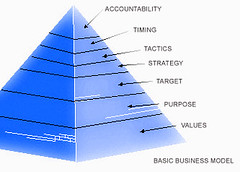One of the definitions that Tom Murphy assigned to his catch phrase "kicking dead dogs" is the continual wave of posts that declare something as dead. I first stumbled across the phrase when I was curious to see what other communication experts might be saying about the concept that the "press release" is dead.
Well, first I would like to clarify that kicking dead dogs is certainly not limited to posts. It wasn't that long ago that Wired Magazine declared newspapers dead. Before that, of course, radio was declared dead with the advent of television. And more recently, blogs were declared dead by John Pretto, who, not surprisingly, is the president of Mr. Podcast, Inc.
Anyway, after awhile, it does make one wonder just what the heck isn't dead. The answer, very simply, is: nothing is dead.
Of course, I already knew this because Bruce Spotleson, publisher of In Business Las Vegas and a self-described "old newspaper" man, is a frequent guest speaker in my Writing for Public Relations class. He has an uncanny way of stating the obvious: no new media has ever replaced another media.
Spot on. Nothing is dead, no matter how much some people might declare it is, press releases included (though I still hate that public relations folks insist on calling a "news release" a press release). What I also find interesting is the number of public relations and communication professionals who are defending the "news release." Most of them, no ill will intended, are speaking passionately enough about press, er, news releases that they are looking at things emotionally instead of objectively.
Shel Holtz is a stand-up guy, for example; he's been in the communication business since the 1970's and I've attended a function or two where he has spoken (we're both accredited business communicators and all). Anyway, Holtz normally defends the concept of a social media release, but backtracked a few days ago by giving Jeremy Pepper's idea some praise:
“What people don't get—especially non-PR people—is that, oh, the majority of PR is done at the local level, where people don't care about blogs or RSS. The local level is done with a press release—sometimes sent over the wire, often not sent over the wire—and done with one-on-one contact," said Pepper.
Murphy jumped on board and says it is the audience that matters "That's why a press release is useful — yes, I know they can be spam — yes I know they can be badly written — but they provide information in a common format that, in most cases, provide the same types of information."
I have to chuckle a bit, not at anyone in particular, but in general. While some public relations professionals are indeed calling for the death of press, er, news releases in favor of social media releases, who really wants this silly issue to become polarized. Is that where public relations is heading? Are we either "for them" or "against them?"
Not here, thank goodness. Maybe we see it all differently. We already know where new media fits in with the old. It's not that hard to figure out.
Here's the bottom line: The social media release concept is a long overdue format to send information to bloggers and social media outlets. The news release still is equally useful (even on the national scale) because, yes, newspapers, magazines, radio stations, television stations, etc. continue to evolve, and have yet to be proven dead.
Come to think of it, I know a couple of companies that still have employee communication bulletin boards too, and use them quite effectively. So what? Big deal if public relations folks have another tool. So what if some ad guys like to be cliche and call everything dead? Since when do communication professionals care about that?
The truth is the only problem with public relations practitioners having another tool is that too many of them are not good enough with the ones they have right now. A news release that is poorly written? Why? A news release that is spam? Why?
If you are a public relations practitioner (like the ones Tom Murphy is talking about) who is sending out poorly written spam as opposed to well-written relevant news releases that are only sent to journalists who might actually want them, then please spare the rest of the world and stick to news releases. Trust me. It won't take long before bloggers will be as unforgiving as editors, tossing those e-mails, letters, statements, and pricey media kits into the trash.
In fact, I just received a news release yesterday. It contained "news" about nothing that I write about or have written about, anywhere, for any magazine or blog. It was poorly written, typos and all. It wasn't even news, really, by any definition. It was spam, pure and simple. Well, it gave spam a bad name. You get the point.
All this leads me back to Murphy's second definition for "kicking dead dogs," which is: why people talk about the same thing over and over and over again. That's easy.
It takes 80 impressions before readers remember good information and another 640 impressions to erase any bad bits of information they read 80 times. Great stuff, by the way, Murphy. Enjoyed your new digs, grumpy and all.
Well, first I would like to clarify that kicking dead dogs is certainly not limited to posts. It wasn't that long ago that Wired Magazine declared newspapers dead. Before that, of course, radio was declared dead with the advent of television. And more recently, blogs were declared dead by John Pretto, who, not surprisingly, is the president of Mr. Podcast, Inc.
Anyway, after awhile, it does make one wonder just what the heck isn't dead. The answer, very simply, is: nothing is dead.
Of course, I already knew this because Bruce Spotleson, publisher of In Business Las Vegas and a self-described "old newspaper" man, is a frequent guest speaker in my Writing for Public Relations class. He has an uncanny way of stating the obvious: no new media has ever replaced another media.
Spot on. Nothing is dead, no matter how much some people might declare it is, press releases included (though I still hate that public relations folks insist on calling a "news release" a press release). What I also find interesting is the number of public relations and communication professionals who are defending the "news release." Most of them, no ill will intended, are speaking passionately enough about press, er, news releases that they are looking at things emotionally instead of objectively.
Shel Holtz is a stand-up guy, for example; he's been in the communication business since the 1970's and I've attended a function or two where he has spoken (we're both accredited business communicators and all). Anyway, Holtz normally defends the concept of a social media release, but backtracked a few days ago by giving Jeremy Pepper's idea some praise:
“What people don't get—especially non-PR people—is that, oh, the majority of PR is done at the local level, where people don't care about blogs or RSS. The local level is done with a press release—sometimes sent over the wire, often not sent over the wire—and done with one-on-one contact," said Pepper.
Murphy jumped on board and says it is the audience that matters "That's why a press release is useful — yes, I know they can be spam — yes I know they can be badly written — but they provide information in a common format that, in most cases, provide the same types of information."
I have to chuckle a bit, not at anyone in particular, but in general. While some public relations professionals are indeed calling for the death of press, er, news releases in favor of social media releases, who really wants this silly issue to become polarized. Is that where public relations is heading? Are we either "for them" or "against them?"
Not here, thank goodness. Maybe we see it all differently. We already know where new media fits in with the old. It's not that hard to figure out.
Here's the bottom line: The social media release concept is a long overdue format to send information to bloggers and social media outlets. The news release still is equally useful (even on the national scale) because, yes, newspapers, magazines, radio stations, television stations, etc. continue to evolve, and have yet to be proven dead.
Come to think of it, I know a couple of companies that still have employee communication bulletin boards too, and use them quite effectively. So what? Big deal if public relations folks have another tool. So what if some ad guys like to be cliche and call everything dead? Since when do communication professionals care about that?
The truth is the only problem with public relations practitioners having another tool is that too many of them are not good enough with the ones they have right now. A news release that is poorly written? Why? A news release that is spam? Why?
If you are a public relations practitioner (like the ones Tom Murphy is talking about) who is sending out poorly written spam as opposed to well-written relevant news releases that are only sent to journalists who might actually want them, then please spare the rest of the world and stick to news releases. Trust me. It won't take long before bloggers will be as unforgiving as editors, tossing those e-mails, letters, statements, and pricey media kits into the trash.
In fact, I just received a news release yesterday. It contained "news" about nothing that I write about or have written about, anywhere, for any magazine or blog. It was poorly written, typos and all. It wasn't even news, really, by any definition. It was spam, pure and simple. Well, it gave spam a bad name. You get the point.
All this leads me back to Murphy's second definition for "kicking dead dogs," which is: why people talk about the same thing over and over and over again. That's easy.
It takes 80 impressions before readers remember good information and another 640 impressions to erase any bad bits of information they read 80 times. Great stuff, by the way, Murphy. Enjoyed your new digs, grumpy and all.


























